Immune adjustment compound, use thereof and pharmaceutical composition comprising same
a technology of immune adjustment and compound, applied in the field of medicine, can solve the problems of series of side effects, reduce immune functioning, reduce etc., and achieve the effects of reducing the number of lymphocytes, and shortened half-lives
- Summary
- Abstract
- Description
- Claims
- Application Information
AI Technical Summary
Benefits of technology
Problems solved by technology
Method used
Image
Examples
example 1
Synthesis of 1-{4-[5-(4-isobutylphenyl)-1,2,4-oxadiazol-3-yl]-benzyl}-3-azetidine carboxylic acid (Compound 1)
1.1 (Z)—N′-hydroxy-4-hydroxymethyl benzamidine (1-3)
[0051]
[0052]Hydroxylamine hydrochloride (1-2, 20.903 g, 300.76 mmol) and sodium bicarbonate (50.5 g, 601.5 mmol) were added successively to a solution of 4-hydroxymethyl benzonitrile (1-1, 20 g, 150.38 mmol) in methanol (250 mL) to obtain a suspension which was then heated to reflux for 5 hours. It was then cooled down to room temperature and filtered. The filter cake was washed with methanol (100 mL), and the obtained filtrate was concentrated to obtain (Z)—N′-hydroxy-4-hydroxymethyl benzamidine which was a white crude product (1-3, 24.8 g of the crude product, 99.3% yield), which was directly used in the next step. The molecular ion peak shown by liquid chromatography-mass spectrometry was: MS (ESI): m / z 167.3 [M+H]+. NMR: 1HNMR (400 MHz, CD3OD) δ: 7.64 (d, J=8.0 Hz, 2H), 7.40 (d, J=8.0 Hz, 2H), 4.65 (s, 2H).
1.2 4-[5-(4-i...
example 2
Synthesis of 1-{2-fluoro-4-[5-(4-isobutylphenyl)-1,2,4-oxadiazol-3-yl]-benzyl}-3-azetidine carboxylic acid (Compound 2)
[0059]
1.1 4-bromo-2-fluorobenzyl alcohol (1-1)
[0060]
[0061]At 0° C., lithium aluminum hydride (1.14 g, 30 mmol) was dropped into a solution of Methyl 4-Bromo-2-fluorobenzoate (4.66 g, 20 mmol) in tetrahydrofuran (100 mL) slowly. The ice-salt bath used was removed after that dropping. The reaction was complete (detected by LCMS and TLC) after stirred for 1 hour at room temperature. The mixture was cooled to 0° C. again and the reaction was quenched with water (1.14 mL) and 10% NaOH solution (11.4 mL) respectively. After stirred for 15 min at room temperature, the mixture was filtered and then the filter cake was washed with tetrahydrofuran (50 mL×2) and ethyl acetate EA (50 mL×2). The filtrate was dried with anhydrous sodium sulfate, filtered, and then concentrated to obtain a colorless oil product (3.4 g, 83% yield).
1.2 3-fluoro-4-hydroxymethyl benzonitrile (1-2)
[006...
example 3
Synthesis of 1-{2-chloro-4-[5-(4-isobutylphenyl)-1,2,4-oxadiazol-3-yl]-benzyl}-3-azetidine carboxylic acid (Compound 3)
1.1 Methyl 4-bromo-2-chlorobenzoate (185312-82-7)
[0072]
[0073]At 0° C., thionyl chloride (3.57 g, 30 mmol) was added dropwise into a solution of 4-bromo-2-chlorobenzoic acid (4.71 g, 20 mmol) in methanol (100 mL) slowly. The ice-salt bath used was removed after that dropping and then the reaction mixture was heated to reflux for 3 hours. TLC and LCMS indicated that starting materials reacted completely. The solvent and excess thionyl chloride were removed by rotary evaporation to give a crude product. Then the crude product was dissolved in dichloromethane (100 mL), washed successively with saturated sodium bicarbonate solution (100 mL×2) and saturated brine (100 mL), dried with anhydrous sodium sulfate and filtered. A yellow solid product (4.79 g, 96% yield) was obtained by rotary evaporation. The molecular ion peak shown by liquid chromatography-mass spectrometry w...
PUM
| Property | Measurement | Unit |
|---|---|---|
| temperature | aaaaa | aaaaa |
| mole ratio | aaaaa | aaaaa |
| temperature | aaaaa | aaaaa |
Abstract
Description
Claims
Application Information
 Login to View More
Login to View More - R&D
- Intellectual Property
- Life Sciences
- Materials
- Tech Scout
- Unparalleled Data Quality
- Higher Quality Content
- 60% Fewer Hallucinations
Browse by: Latest US Patents, China's latest patents, Technical Efficacy Thesaurus, Application Domain, Technology Topic, Popular Technical Reports.
© 2025 PatSnap. All rights reserved.Legal|Privacy policy|Modern Slavery Act Transparency Statement|Sitemap|About US| Contact US: help@patsnap.com



